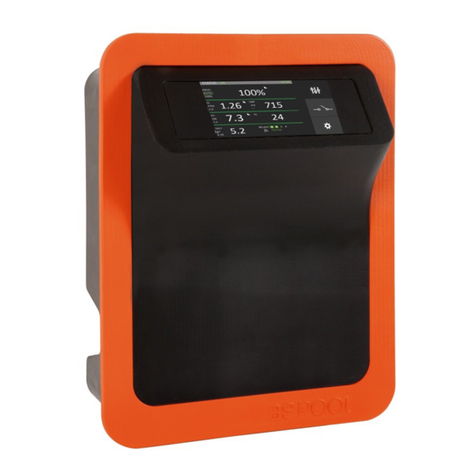Manual PRO v.2 33 / 53
-It is important to ensure that the supply cables of the
electrolysis cell are tightly connected, otherwise the equipment
could overheat and break down.
-Ensure that the heatsink wings are not blocked and that air can easily
circulate through them.
-BSV PRO equipment incorporate protection systems against short circuits
in the cell, absence of water detector and other safety systems that give
an acoustic and visual alarm in the event of any anomaly. However, for
optimum results, you should ensure the correct hydraulic operation of
your swimming pool.
-Corrosive environments may reduce the lifespan of the equipment. Do
not leave open containers with acids near the equipment.
2- PREPARING THE SWIMMING POOL
2.1- Adding salt to the water
Para que el clorador funcione correctamente deberá incorporarse una pequeña
cantidad de sal y asegurarse de que el nivel de pH del agua sea el adecuado.
Los niveles de sal y pH
recomendados son los siguientes:
pH del agua de la piscina------------------- 7,1 a 7,4
Proporción de SAL en kg/m3-------------- 4 a 6
To ensure that the chlorinator works correctly, a small amount of salt should be
added and the pH level should be suitable.
The recommended salt and pH levels are the following:
pH of the swimming pool water------------------- 7.1 to 7.4
Proportion of SALT in kg/m3-------------- 4 to 6
Although the equipment will start to operate with lower amounts of salt, the
optimum production of salt will be reached with concentrations of over 4kg/m3.
We recommend a concentration of 5Kg/m3 to offset small losses of salt
occurring when cleaning the filter, the effect of rainfall, etc.
To calculate the salt to be added, multiply the total m3 of your swimming pool
x 5.
Example :
A swimming pool measuring 9m in length x 4.5m in width x 1.6m in
depth.
9 x 4.5 x 1.6= 64.8 cubic metres. 64.8 x 5 = 324 Kg of salt to be added.




























